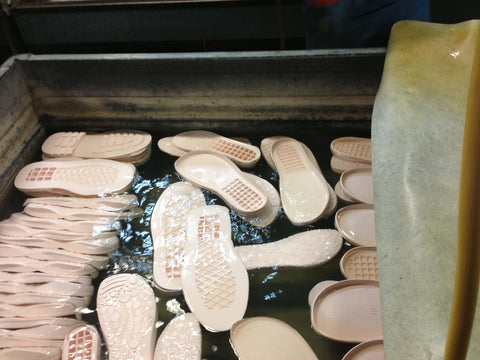The Best Soles in the World - Lactae Hevea
When I made plans to attend Bread and Butter in Berlin I knew that I had to make time to meet some friends and contacts in France. My flight was connecting through Paris, so this was a no-brainer. At the top of my priorities was to visit Reltex in Virieu, a very small mountainside town situated between Lyon and Grenoble. It was a little bit of a challenge to get there: two and a half hour train, met at the station by Patrick Giroud, the President and founder of Reltex, and then a 45 minute drive on winding roads just outside of the French Alps.
I instantly found Mr. Giroud to be warm, welcoming and humorous. He truly has a passion for his trade, it is no surprise then that he continues to do it even at 72. Reltex and Mr. Giroud are responsible for bringing the world Lactae Hevea (pronounced lack-tie heavy-ah, the "h" on "hevea" is silent but you'd sound pretentious pronouncing it that way in this country) latex outsoles. Lactae Hevea literally means milk of the hevea tree in Latin. The soles are made from the sap or milk of the hevea tree. Essentially, it is 100% natural latex rubber.
The milk is harvested in Malaysia, Indonesia, and Vietnam using sustainable methods and shipped to the tiny town of Virieu in France, where a passionate and intelligent man developed a process for creating the most comfortable and durable rubber outsoles in the world. There really is nothing like it in the world, and nobody else does it. It is tedious and expensive and imprecise.
The milk is poured by hand into steel molds. The steel molds are resting in a warm water bath and will set in the bath for one hour before they remove the sole and transfer it immediately into a cold water bath. At this point, the soles have the consistency of jello and are an odd off-white color.
The rubber soles have a uniquely porous micro-structure, and the cold water bath helps keeps those pores open while the material cures. After one full day in the cold water they go into a hot-air dryer for one day. The dryer is huge and has hundreds of wooden shelves to hold the unfinished soles. After 24 hours drying, they put the soles back into the water for a day to keep those pores open, then back into the dryer for a full week until the soles are finished. The final process is trimming any imperfections and inspecting the final product before packing. It takes roughly 10-12 days to produce one pair of soles, a stark contrast from the minutes or hours it takes other manufacturers to produce rubber soles.
At Reltex, producing these latex soles is a fluid process (no pun intended). If they feel the soles need more drying, they dry them longer. The colors are difficult to master as well because they are working with a natural and living raw material. Each batch will be a slightly different color. The drying, which speeds up the curing process, is only half the battle. The soles actually take months to properly cure. But with a worldwide culture that needs immediate gratification, we just can't wait. So when we cut and trim these soles to fit our shoes, we get to see the uncured milk inside the soles. We typically cover it up with dye, however in just a short couple of months the soles will cure fully and that light natural milk color will be gone.
In our opinion Lactae Hevea soles, while expensive and imprecise, are the greatest outsoles in the world. They offer unparalleled comfort and durability. Not to mention they look great on just about any style of shoe we produce and the story of how they are made just doesn't get any better. We are currently expanding our offering of Lactae Hevea soles but for now you can find them here
























